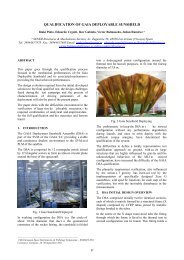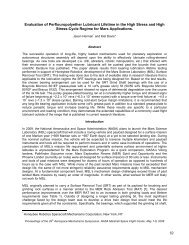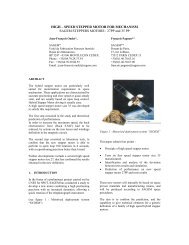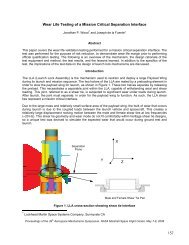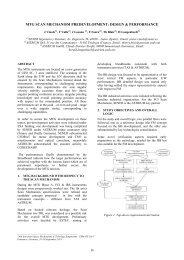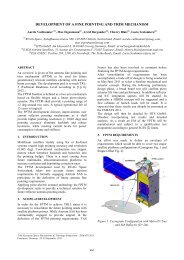Miniaturized Single-Shot Valve and its Application to the ExoMars ...
Miniaturized Single-Shot Valve and its Application to the ExoMars ...
Miniaturized Single-Shot Valve and its Application to the ExoMars ...
Create successful ePaper yourself
Turn your PDF publications into a flip-book with our unique Google optimized e-Paper software.
Therefore o<strong>the</strong>r solutions were considered. A self-opening valve consists of two main elements: <strong>the</strong><br />
sealing element, <strong>and</strong> an actua<strong>to</strong>r. All combinations of existing sealing elements <strong>and</strong> actua<strong>to</strong>r were listed,<br />
<strong>and</strong> it appeared that sealing valves is a field that requires more exploration. Who has ever built a sealing<br />
valve with a piezoelectric actua<strong>to</strong>r? To <strong>the</strong> current knowledge this has never been done. This seems also<br />
<strong>the</strong> case for a valve working with a bimetallic snap-disc.<br />
This paper first explains <strong>the</strong> motivation of this development, in particular <strong>the</strong> function <strong>the</strong> valve has <strong>to</strong> fulfill<br />
in <strong>the</strong> MOMA gas chroma<strong>to</strong>graph. After this, <strong>the</strong> basic design <strong>and</strong> <strong>the</strong> refined design of <strong>the</strong> valve are<br />
developed. Finally, <strong>the</strong> valve was tested <strong>and</strong> <strong>the</strong> design reviewed.<br />
Figure 2. Diagram of <strong>the</strong> applications of <strong>the</strong> valve.<br />
Purpose<br />
MOMA is a project of <strong>the</strong> Max Planck Institute for Solar System Research <strong>and</strong> <strong>the</strong> Labora<strong>to</strong>ire<br />
Atmospheres, Milieux, Observations Spatiales. The MOMA objective is <strong>the</strong> analysis of <strong>the</strong> Martian soil<br />
composition during <strong>the</strong> <strong>ExoMars</strong> mission. It consists mainly of a gas chroma<strong>to</strong>graph <strong>and</strong> a laser<br />
spectrometer. The gas chroma<strong>to</strong>graph uses helium <strong>to</strong> carry <strong>the</strong> evolved gases from <strong>the</strong> heated soil<br />
sample <strong>to</strong> <strong>the</strong> capillary columns, as shown in Figure 1. The speed of <strong>the</strong> gas flow is regulated by a<br />
<strong>the</strong>rmal regulation valve in which <strong>the</strong> flow is controlled by a sapphire ball compressed <strong>to</strong> <strong>the</strong> aperture <strong>to</strong> a<br />
higher or lower level. The compression of <strong>the</strong> ball is determined by <strong>the</strong> <strong>the</strong>rmal expansion of <strong>the</strong> body of<br />
<strong>the</strong> regulation valve, which is heated by a resis<strong>to</strong>r. In this continuous process <strong>the</strong> regulation valve opens<br />
as <strong>its</strong> temperature is increased. Here a key problem appears, as <strong>the</strong> entire instrument is heated up during<br />
<strong>the</strong> sterilization process required by <strong>the</strong> committee on space research for missions <strong>to</strong> <strong>the</strong> Martian surface:<br />
If no o<strong>the</strong>r device is hermetically closing <strong>the</strong> gas tank during sterilization, it would lose <strong>its</strong> contents. The<br />
main focus of <strong>the</strong> development presented here is <strong>to</strong> have a valve that truly hermetically seals <strong>the</strong> tank,<br />
before it is opened by breaking <strong>the</strong> seal. The initial hermeticity is <strong>the</strong> key point <strong>to</strong> select a single-shot<br />
valve principle.<br />
The projected valve has <strong>to</strong> be very lightweight (maximum 10 g), as <strong>the</strong> mass budget of <strong>the</strong> scientific<br />
instrument is very limited. The flow rate does not need <strong>to</strong> be very large, as <strong>the</strong> typical flow rate of helium<br />
NASA/CP-2010-216272<br />
342



